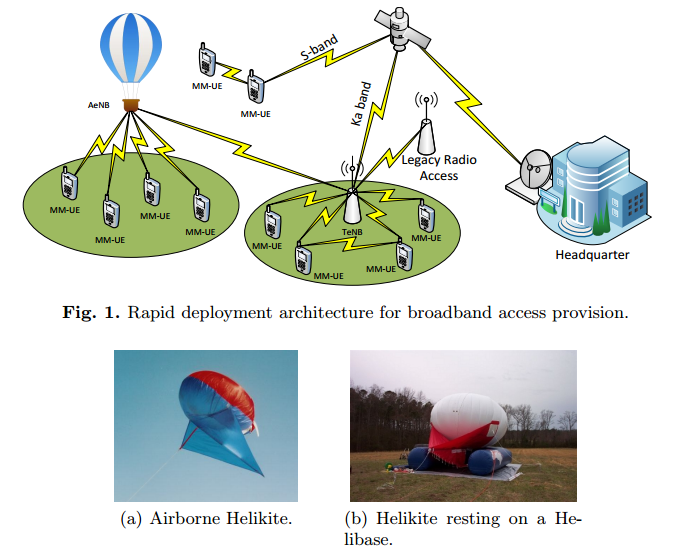An Inflatable Emergency Airborne Communications Network
Most people will have had the experience of being unable to get a mobile phone signal at a major sporting event, music festival or just in a crowded railway station. The problem becomes even more acute in emergency situations, such as in earthquake disasters zones, where the telecommunications infrastructure has been damaged.

So the ability to set up a new infrastructure quickly and easily is surely of great use.
Today, Alvaro Valcarce at TRiaGnoSys, a mobile communications R&D company in Germany, and a few pals unveil a system that could make this easier. These guys have developed a rapidly deployable wireless network system in the form of airborne base stations carried aloft by kite-shaped balloons called Helikites with a lifting capacity of 10 kg and that can remain airborne at an altitude of up to 4 km for several days, provided the weather conditions allow.
Valcarce and co say the system can be quickly deployed and provides large local mobile phone coverage thanks to a combination of multiple airborne nodes that link in to terrestrial and satellite telecommunications systems.
Their idea is that these systems could be deployed by network companies during temporary events such as the Olympic Games, or by first responders to an emergency event to set up the vital communications infrastructure necessary to coordinate emergency services.
One of the key challenges is to get the new equipment to work seamlessly with existing terrestrial networks. And to that end, Valcarce have been testing their airborne Helikite.
The team has a number of challenges to overcome in its ongoing work. For example the altitude of the Helikite determines its coverage but also influences the network capacity and delays. Evaluating these effects is one part of their future goals.
Having ironed out these kinds of operational problems, such a system will surely be valuable in a wide range of situations where reliable communication is not just a useful bonus but a life-saving necessity.
Ref: arxiv.org/abs/1307.3158 : Airborne Base Stations for Emergency and Temporary Events
Keep Reading
Most Popular
Large language models can do jaw-dropping things. But nobody knows exactly why.
And that's a problem. Figuring it out is one of the biggest scientific puzzles of our time and a crucial step towards controlling more powerful future models.
The problem with plug-in hybrids? Their drivers.
Plug-in hybrids are often sold as a transition to EVs, but new data from Europe shows we’re still underestimating the emissions they produce.
Google DeepMind’s new generative model makes Super Mario–like games from scratch
Genie learns how to control games by watching hours and hours of video. It could help train next-gen robots too.
How scientists traced a mysterious covid case back to six toilets
When wastewater surveillance turns into a hunt for a single infected individual, the ethics get tricky.
Stay connected
Get the latest updates from
MIT Technology Review
Discover special offers, top stories, upcoming events, and more.